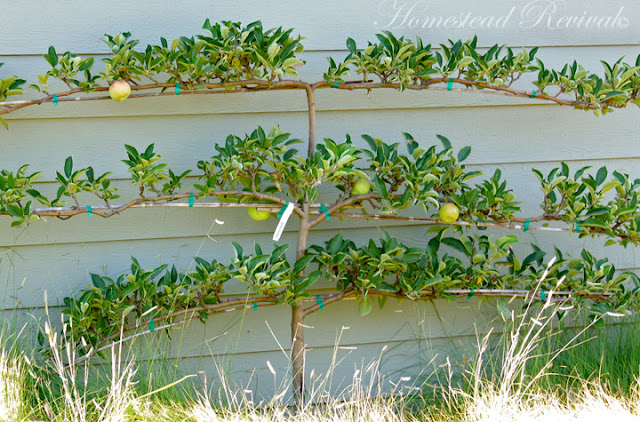Caroline at Boho Farm blog really inspired me that I could do this. When reading her post, "What's Growing at the Boho Farm", her espalier apple tree quickly caught my eye! The trained branches against the back drop of her white fence are simply gorgeous! (Be sure to visit her blog for more photos of her lovely homestead!)
In truth, I had just about given up that I could do this or that it was worth it. Two years ago, when visiting Napa, I saw several at the Farmhouse Restaurant in St. Helena, CA. I loved the idea but pruning is not my forte! I'm totally intimidated by cutting branches off an otherwise healthy plant.
Trained the trees around
a patio dining area creating a fence
Espalier apple tree against the side of the building -
the solid backdrop showimg off tree's lovely form
Another concern was the fact that an espalier would produce less fruit than a standard tree. While that may be true, it seems that all that pruning can cause the fruit that does grow to be sweet and delicious. Not to mention the aesthetic value.
As I was reading Born Again Dirt by Noah Sanders, he mentioned that trees in nature are scattered and mixed, not all together. While he is clear that small orchards are not a problem, I realized perhaps I should consider NOT planting all my apple trees in one location: a few espalier trees in one area with the rest scattered in different areas of the yard so as accent other areas with beauty. This practice also helps with bug infestations by controlling the spread from tree to tree due to plants of the same kind being in close proximity to each other.
Then, as I was reading Michael Bunker's book Surviving Off Off-Grid, he suggests growing plenty of extra fruits and vegetables to have some to feed to your animals as well as sharing with those in need. I doubt if an espalier tree would be sufficient for this, but I wanted to meet production goals as well.
I've wanted a potager garden for almost as long as I've been gardening, and I decided that giving up on that dream was not something I wanted to do. So in the end I decided to train part of my trees in espalier fashion and the rest would be grown traditionally in some strategic locations throughout the yard with a few in a small orchard. This way I'm planting some for production and some for flavor and beauty, but Lord willing, all should produce fruit for our various needs.
Food production is important, but so is beauty for the soul! When both function and beauty can be achieved, it is desirable to do so!
How To Train a Tree in Espalier Fashion
Apparently there are a couple of ways you can do this. Either method will require you to have wire support or a sturdy trellis with "arms" in the desired pattern. For this post, I'm going to only talk about a simple pattern called Double or Triple Corndon, like the photos above . At the end of this post, I've included a video links for information on how to prepare your wire supports. In my case, I just used an existing fence line that was very sturdy.
1) Bare Root Stock. In this method, you prune the tree down to the first cordon that is at the lowest point, cutting just above two buds that are on either side, forcing new branches to grow. Trim all but the two desired cordons and one vertical branch that will go up to the next cordon. When it is well above the next level, trim again just above two buds, forcing multiple branches once again. Continue this pattern until you've reached the top cordon, at which point you will only leave the two side branches. This method will take about 4 years for your branches to fill out to three cordons, but you'll have branches pretty much right where you want them. Patience should pay off in this method!
2) Potted Trees. Carefully select a potted tree with side branches about the same height. These will be the cordons. Cordons should be evenly spaced as well, so keep this in mind when looking at the branches on the tree. Plant and train selected branches to the cordon wires and trim away excess branches. This method seems quicker, but it's hard to find trees with existing branches right where you need them.
I'm FAR from being an expert here... learning as I go. But perhaps a couple of video clips will help you get started.
Here's hoping all your garden dreams come true!








